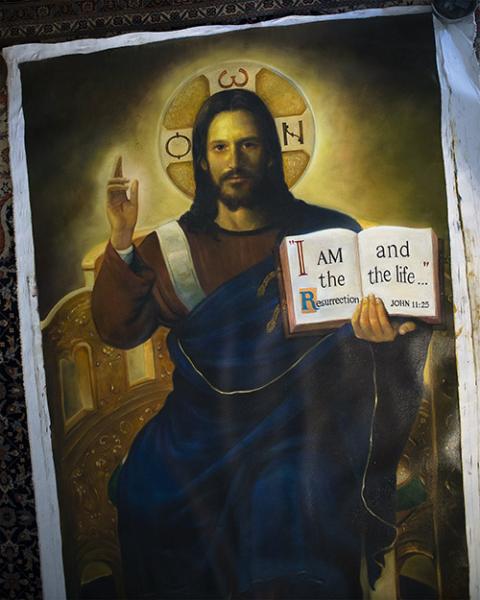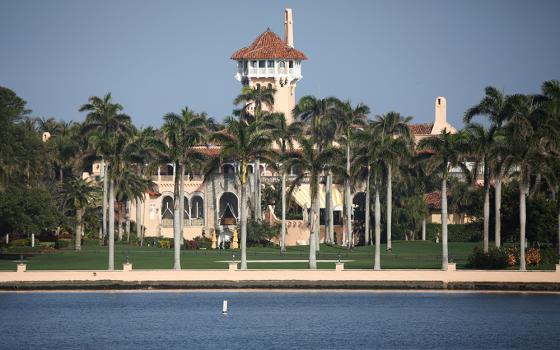
A wonky detail of praying hands from an AI-generated image (Pixabay)
As the presence of artificial intelligence in our daily lives expands, so too do the ethical problems posed by the technology. As a Christian, I'm increasingly concerned with AI's presence in one of the most powerful artistic forms: religious art.
While preparing a guest lecture in a colleague's classroom, I turned to the web to find electronic scans of religious artworks for my slide deck.
As I browsed my search engine of choice for Christ Pantocrator and Mary cradling baby Jesus, I was met with numerous options. Upon closer inspection, however, I noticed uncanny features in the first few search results.
In one depiction of Christ Pantocrator, he was missing several fingers, and his facial features were slightly smudged and contorted. In another depiction of Christ gesturing toward an open Bible, the text was gibberish instead of the typical Greek or Cyrillic characters. In yet another depiction of Christ, his "sacred heart" instead resembled a shapeless, golden blob.
It didn't take me long to realize that these depictions were all AI-generated.
I've noticed a similar trend when scrolling on social media. As someone who is connected to Christian communities on apps like Facebook and X (formerly Twitter), I've seen more and more AI-generated religious depictions.
My latest discovery in AI "iconography" was on Instagram, where I found an account that posts animated depictions of religious figures. One video cycles through a scene of the Visitation, where Elizabeth and Mary babble silently while their faces contort, and then the video abruptly cuts to Mary walking with Jesus, her hand passing directly through his head while a peacock and golden retriever trail behind them. No exaggeration.
Advertisement
At first glance, these depictions strike us as benign. Sure, they're a little tacky, and shoddy replacements for the "real thing" — the meticulous art of faithful Christians from throughout the centuries — but what harm can they really be, especially if they're appealing enough to attract thousands of likes and hundreds of comments from eager devotees?
Still, I couldn't shake how unsettled I felt by these depictions. After learning about the ethical problems underlying generative AI tools, I've become convinced that AI directly contravenes God's commandments —and AI-generated "religious art" is no different.
Generative AI programs, like Midjourney and Dall-E might seem innocent, but there's always a catch to a technology that supplies on-demand results for free. In the case of generative AI, where I can type any prompt into a program and receive an image in mere seconds, the deeper implications are sinister.
According to computer manufacturing corporation NVIDIA, generative AI models "use neural networks to identify the patterns and structures within existing data" to generate prompt-driven content for users. AI programs are trained on preexisting content, and then spit out something based on them —without acknowledging the source material. In other words, AI "scrapes" preexisting media on the internet and repackages it as something new or original — completely obscuring the sources from which it skimmed.
So, in order to generate a babbling Mary or uncanny Christ, the AI program has to draw from original sacred images — from scans of the Orthodox Church's most revered icons to the images adorning the Sistine Chapel — and jumble them together with other unattributed material on the internet.
While AI-generated images based on open-access materials may not seem egregious, we should remain concerned by AI manipulating venerated artworks for novelty's sake.

The Greek letters Ο, Ω and Ν are seen in the halo of an icon of Christ "Pantocrator" by Sulpician Fr. Peter Gray. (CNS/Tyler Orsburn)
I'm particularly troubled by AI depictions that repackage Orthodox icons. In the Orthodox tradition, iconographers undergo intentional training, apprenticeships and spiritual formation to produce these holy images. Every letter and shape has spiritual meaning. For example, in Christ's halo, the Greek letters Ο, Ω and Ν are used to express ὁ ὢν — "ho ōn", literally, "the Existing One," signaling Christ's divinity. Yet AI obscures these letters, or turns them into shapeless gibberish.
Today, artists are raising the alarm about generative AI's violation of intellectual property and source attribution. While more and more secular artists are building a legal case against AI, I see a moral case against AI that Christians should consider.
I have seen generative AI used to promote religious webinars; used for religious book covers on Amazon; and even creep into parish bulletins. Where the church and its faithful have had the opportunity to support and promote contemporary religious artists, they chose instead to take from them.
This is yet another reason to oppose AI, as these programs reduce the incentive to support artists in the church. After all, why commission a Catholic artist for artwork in your parish bulletin or your theology book, or displayed in the church, when you can generate a slightly similar, albeit wonky, artwork for free?
I will not mince words: By stealing content without source attribution, AI-generated devotional images violate more than our senses — they also violate the Eighth Commandment. As God commanded Moses, "Thou shalt not steal," and yet we do.
As a former student, I know the importance of source attribution. I can hardly forget my English teachers' insistence that without crediting the original source, I was committing plagiarism. How unsettling it is to see educational institutions capitulate to AI programs and other learning language models.
Will our religious institutions be next? While I hope not, as the moral costs are great, I have my concerns. We've already had an AI-generated priest — now we have a Swiss church using generative AI to display a virtual Jesus who can speak to devotees.
There's other ethical aspects to AI that deepen its contravention of God's commandments, and further convince me that we should reject generative AI.
For example, AI has been linked to exploitative labor. A 2022 Time magazine investigation uncovered labor exploitation in OpenAI's system training processes, and found that subcontracted Kenyan data labeler-workers were paid as little as $1.32 per hour to train AI systems.
On Nov. 24, CBS aired a "60 Minutes" segment that corroborated these findings. Interviewed workers cited punitive deadlines, terrible working conditions and emotional distress, as many had to sift through "the worst of the worst" online content to train the AI. As one interviewee disclosed, "I was watching dismembered bodies or drone attack victims. You name it. You know, whenever I talk about this, I still have flashbacks."
The exploitative working conditions underlying AI systems are also a form of theft; these systems are stealing workers' dignity. In this way, generative AI simultaneously violates the Eighth Commandment and the love commandment.
What's more, AI programs have grave environmental costs, contributing to staggering energy and water usage. Because AI systems rely on data centers that require cooling mechanisms to function, current expansions prove extremely water-intensive.
AI's environmental burdens further violate the Eighth Commandment by stealing a stable ecological future from younger generations. All for the sake of a Jesus emoji.
With the global water supply already at risk, generative AI for "sacred" images becomes all the more profane. AI's environmental burdens further violate the Eighth Commandment by stealing a stable ecological future from younger generations. All for the sake of a Jesus emoji.
The fact that our institutions eagerly pour time and money into this extractive and destructive technology is disturbing. Our casual use of this technology for "religious art" is unjustifiable. What will we tell our children, that we worsened labor and environmental conditions for ugly, uncanny images?
I'm tired of our institutions treating AI usage as an inevitable and unstoppable technology, especially when the technology is predicated on theft. I'm not convinced that we need to adapt to AI or use it "for the good of the faith." On the contrary, I'm convinced we need not use it at all.
At this venture, Christians have the opportunity to be the first to eschew generative AI, to reject it outright and to reject its widespread use as inevitable. In a world with abundant public-domain (that is, free!) Christian art, and contemporary Christian artists eager for their work to be shared with the world, there's little excuse to choose generative AI for the Facebook feed or the parish bulletin.
When we feel compelled to choose the easy or convenient way as provided by generative AI, let us instead choose the moral way outlined by Christ. Let's eschew theft and commit ourselves to the common good. To that end, let's step away from AI, and instead step into community, restoring the world that God has made for us.









